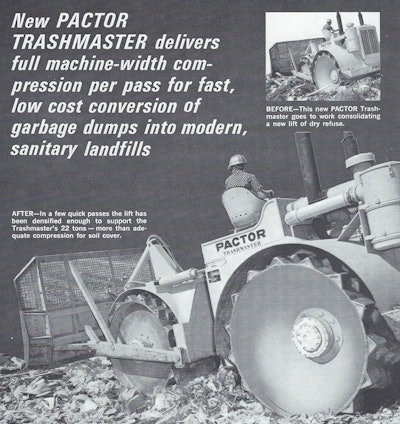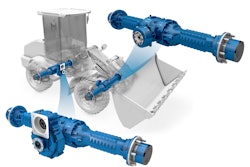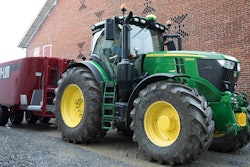
Most advances in construction and infrastructure equipment is due to the need or desire to do work faster, more productively, more safely and less expensively; thus, most of these advances are improvements on existing ideas. But once in a while a truly new need arises that requires technology to move into an entirely new direction.
The history of how solid waste disposal changed from a simple dump to today’s carefully managed sanitary landfills is for someone else to explore, but suffice it to say that equipment purpose-built for compacting garbage did not exist until the 1960s. Since then, sanitary landfills have developed into carefully engineered structures designed to contain waste and its byproducts, and crawler tractors, crawler and wheel loaders, and compactors have been designed for the special demands and safety requirements of this work.
As early as 1966, Pactor Corporation of West Sacramento, CA, introduced a variation of its unique line of three-wheeled, full-width embankment compactors designed for use in solid refuse. (Pactor was acquired by Rex Chain Belt around this time, and the design evolved into what is now the CMI Trashmaster.) While the design has of course evolved since then, the basic features of landfill compactors include steel wheels outfitted with cutters, teeth or other implements designed to use the compactor’s speed and weight to crush, demolish and consolidate waste and eliminate voids and air pockets so as to reduce it to its smallest possible mass while not picking the trash up in the wheels; a heavy-duty dozer blade suitable for handling trash or dirt, with a tall screen on top to keep trash from riding over it; and plenty of protection for the operator.
Most of these machines follow the Pactor idea of following the basic design of a landfill compactor, although the Pactor/Rex/CMI line is the only one to use three drums. Some of these machines are quite ponderous; for example, Caterpillar’s 836K weighs in at over 60 tons and is 14 ft. (4.3 m) wide across the wheels. As it is with so much other machinery, small- to mid-sized machines are sufficient for many applications. Other landfill compactors are adaptations of wheel loaders and, in the case of Caterpillar’s 518, a log skidder.
The Historical Construction Equipment Association (HCEA) is a 501(c)3 non-profit organization dedicated to preserving the history of the construction, dredging and surface mining equipment industries. With approximately 4,000 members in 25 countries, activities include publication of a quarterly educational magazine, Equipment Echoes; operation of National Construction Equipment Museum and archives in Bowling Green, OH; and hosting an annual working exhibition of restored construction equipment. The 2019 show will be September 13-15 at the Museum in Bowling Green. Individual memberships within the USA and Canada are $35 for one year, $65.95 for two years and $99.95 for three years, and $55.00 US elsewhere. HCEA seeks to develop relationships in the equipment manufacturing industry, and offers a college scholarship for engineering and construction management students. Information is available at www.hcea.net, by calling 419-352-5616, or e-mailing [email protected].



















